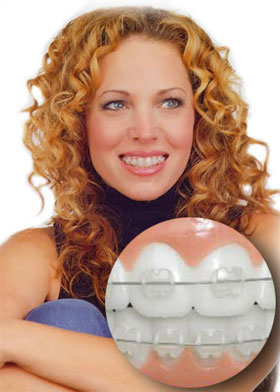Benefit of orthodontic treatment
Benefit of orthodontic treatment :
Orthodontics can be beneficial for both children and adults.
Orthodontic appliances can be used to treat many dental and maxillofacial disorders .
Benefit of orthodontic treatment :
Orthodontics can be beneficial for both children and adults.
Orthodontic appliances can be used to treat many dental and maxillofacial disorders .
The first treatment session usually begins with question about the patients main complaint and physical health and a history of previous illnesses.
Orthodontics in adulthood improves the appearance of the face and smile, improves the health of teeth, gums and ultimately leads to increased self-confidence.
Smile is one of the most important features of facial beauty and one of the main pillars of attractiveness of any person. , Severe tooth wear and eventually temporomandibular joint pain.


Therefore, modern orthodontics is a way to facilitate other dental treatments such as restoration and veneering of teeth, removal of gum diseases, denervation and dental implants. Today, the number of adults undergoing orthodontic treatment is increasing in the world. This is because this type of treatment is used to eliminate crooked and irregular teeth, non-mating of teeth, space between teeth, protruding gums when smiling and problems in chewing and talking.
Gingival and bone resorption, the presence of denervated teeth with extensive veneers and restorations, or even controlled diabetes do not preclude orthodontics in adults.
Common reasons for orthodontic treatment in adults include the following:
1) crooked and irregular teeth
2) No pairing of teeth
3) Existence of space between teeth
4) Pain, pressure or sound in the jaw joint
5) Promote oral health, teeth and gums
6) Improve the smile design
7) Excessive gum display when smiling
8) Difficulty chewing and talking
.
Currently, the use of modern tools for orthodontics has reduced the length of treatment and increased treatment options for the patient.
At present, orthodontics in adults use a base called a bracket that is placed on the tooth. These brackets are available in several types of metal, ceramic (transparent), plastic and lingual (lingual).
Many orthodontists today use soft tissue lasers to increase the effectiveness of orthodontic treatment and make treatment easier. The laser was first used in dentistry in 1964, and since then, continuous advances in laser technology have made it one of the most effective and best devices for soft and hard tissue treatments. Lasers can have applications in orthodontics. Many of the types of dental lasers currently available can also be used for hard and soft tooth tissue applications in dental orthodontics. To achieve the desired effects on the target tissue, knowledge of laser features such as power, wavelength and timing is essential. Laser therapy can be beneficial.
* In Dr. Golshah’s office, an American-made laser is used to improve and accelerate the orthodontic work of patients. *
The laser used in orthodontics is a special type of pigmented or colored tissues. Orthodontic laser is a soft tissue diode laser used for gingival surgery. The laser simultaneously removes excess tissue with incredible precision, stops bleeding, and disinfects the surgical site. Because the laser is high in concentration, it does not damage adjacent tissues, so inflammation does not occur and the wound heals quickly. In addition, laser surgery is almost painless. Laser speeds up orthodontic treatment and gives more beautiful results.
Use of laser in orthodontic treatment
Lasers can be used for orthodontic treatment in many common applications, including accelerating tooth movement in bone and preparing enamel before banding, banding in ceramic brackets and reducing post-orthodontic pain, and preventing enamel decay. Also, soft tissue applications between the gums and the length of the crown can be obtained using dental lasers.
Pain relief using orthodontic laser
After the initial use of orthodontics, the patient feels pain or discomfort for a limited time. Low power lasers can be used as an analgesic treatment for orthodontic patients. Many researchers have reported that the use of lasers has analgesic effects to reduce the pain of orthodontic treatment.
Benefits of Laser Therapy in Dentistry
Shorter recovery time: Wiring teeth sometimes causes mouth sores. These wounds are painful. With a laser, this area can be anesthetized and the healing process can be accelerated.
Accurate positioning: The laser is used to shorten the muscle connections between the lips and gums, the phrenum. An enlarged or elongated phrenum can cause teeth to become disordered. The laser is so accurate that it does not cause the slightest damage to the surrounding tissues during phrenic surgery.
Gum Shaping: Gum surgery makes the front teeth more beautiful. The surface of the gums sometimes looks uneven after the teeth are arranged. Using a laser, you can even out the height of the gums to create a more beautiful smile.
Tissue removal: Sometimes the gum tissue covers the teeth. In order to move the teeth, the bracket must be attached to the teeth; To attach the bracket, the extra gum tissue must first be removed. The dentist can use laser to remove excess tissue quickly and easily.
Improved access: The formation of excess tissue is sometimes the result of poor oral hygiene, in addition, if the teeth are wired, scaling becomes difficult. Excess tissue grows on the surface of the tooth, making scaling more difficult. The dentist can use a laser to remove swollen gums to improve access to the enamel.
Pain control: Laser therapy is often used because of its analgesic effect. The laser beam stabilizes the nerve membrane and reduces pain transmission. The laser can be used on most deciduous teeth and for small restorations of permanent teeth.
The benefits of lasers for cosmetic purposes in dentistry
Laser teeth whitening in orthodontics (bleaching)
Smile correction surgery
Lighten the gums
Correction of gingival enlargement
Low power laser related to orthodontic treatment
Dental lasers provide comfort and accuracy during soft tissue incisions. They minimize soft tissue damage, control bleeding, and can also reduce postoperative pain.
Laser phrynctomy and extra gum resection in orthodontics
When the orthodontist feels the need to remove the soft tissue between the mandibular and maxillary teeth in some cases to close the gap (diastem), this surgery is much easier with the help of laser. A razor is much more difficult than a laser. Laser surgery is painless and bleeding-free and is performed faster and does not require stitches. In addition, gum repair is much faster than razor surgery.
Does orthodontics affect the size of the nose? The small or large size of the nose is the perception we have of the proportions of the face and the position of its components. When these proportions and positions collide, the dimensions we imagine will be more or less than real. By performing orthodontic treatment and moving the jaws and teeth, the shape of the lips and its position are affected so that it returns to its correct position and fit. This causes the perceived size of your nose to change from before, and as the proportions of your face improve, it will likely become more proportionate to the size of your nose.
The general public believes that orthodontics only beautifies and tidies the teeth, while this belief is wrong. Orthodontics is a treatment used to maintain the function and health of the oral cavity and masticatory muscles.
Rhinoplasty before orthodontics or after orthodontics?
One of the most common questions asked by many patients who intend to have orthodontic treatment and rhinoplasty is whether to have orthodontic treatment earlier or rhinoplasty ??
Patients should keep in mind that since orthodontics can affect the shape and position of the lips by moving the teeth, it is better to end orthodontic treatment first, so that after stabilizing the position of the lips and jaw, the patient undergoes cosmetic surgery. Pay the nose.
In rhinoplasty, one of the important things that the surgeon considers for the final shape of your nose is its relationship to the lips (keep in mind that the shape of the lips will change after orthodontic treatment). It is also possible that during Orthodontic treatment The orthodontist puts pressure on the nose, so it is recommended that rhinoplasty be performed after orthodontics.
Finally, it is recommended that you consult your orthodontist before having rhinoplasty.
